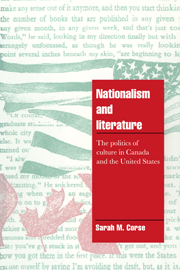Book contents
- Frontmatter
- Contents
- List of tables
- Acknowledgments
- 1 Introduction: cultural fields and literary use
- 2 Nation-building and the historical timing of a national literature in the United States
- 3 Nation-building and the historical timing of a national literature in Canada
- 4 The canonical novels: the politics of cultural nationalism
- 5 The literary prize winners: revision and renewal
- 6 The bestsellers: the economics of publishing and the convergence of popular taste
- 7 Literary meaning and cultural use
- Appendix A The canonical novels
- Appendix B The literary prize winners (1978–1987)
- Appendix C The bestsellers (1978–1987)
- Appendix D Coding sheet
- Appendix E Generic categories
- References
- Index
7 - Literary meaning and cultural use
Published online by Cambridge University Press: 11 May 2010
- Frontmatter
- Contents
- List of tables
- Acknowledgments
- 1 Introduction: cultural fields and literary use
- 2 Nation-building and the historical timing of a national literature in the United States
- 3 Nation-building and the historical timing of a national literature in Canada
- 4 The canonical novels: the politics of cultural nationalism
- 5 The literary prize winners: revision and renewal
- 6 The bestsellers: the economics of publishing and the convergence of popular taste
- 7 Literary meaning and cultural use
- Appendix A The canonical novels
- Appendix B The literary prize winners (1978–1987)
- Appendix C The bestsellers (1978–1987)
- Appendix D Coding sheet
- Appendix E Generic categories
- References
- Index
Summary
I began the book by enumerating the inadequacies of reflection theory for an explanation of national literatures. Now, however, I wish to return to the issue of “reflection” more broadly understood. In the simple sense of the term, literary reflection does occur in that characters, settings, and plot devices in fiction tend to resemble “real” people, places, and events. Not surprisingly, there is a connection between literature and society. The problem remains, however, that reflection theory is not sufficient to explain which aspects of the social environment are included in literature, which aspects are excluded in literature, and which aspects are ignored.
Ramona's famous question about how Mike went to the bathroom while working all day with his steam shovel is a classic example of this latter insufficiency of reflection theory. Everyone goes to the bathroom, but few authors detail the fact. The “failure” of literature to reflect such aspects of everyday life is obviously driven in part by the requirement for significance in art. But on a larger scale than the absence in most literature of quotidian activities such as eating, urinating, and blowing one's nose, the underlying problem remains. Of course literary depictions draw upon real life. But how do we understand the process by which real life is selectively transformed into literary life? And, more importantly in the case of canonical novels and literary prize-winning novels, how do we understand why it is that this novel or this author is valorized when so many are relegated to obscurity?
- Type
- Chapter
- Information
- Nationalism and LiteratureThe Politics of Culture in Canada and the United States, pp. 155 - 170Publisher: Cambridge University PressPrint publication year: 1996

